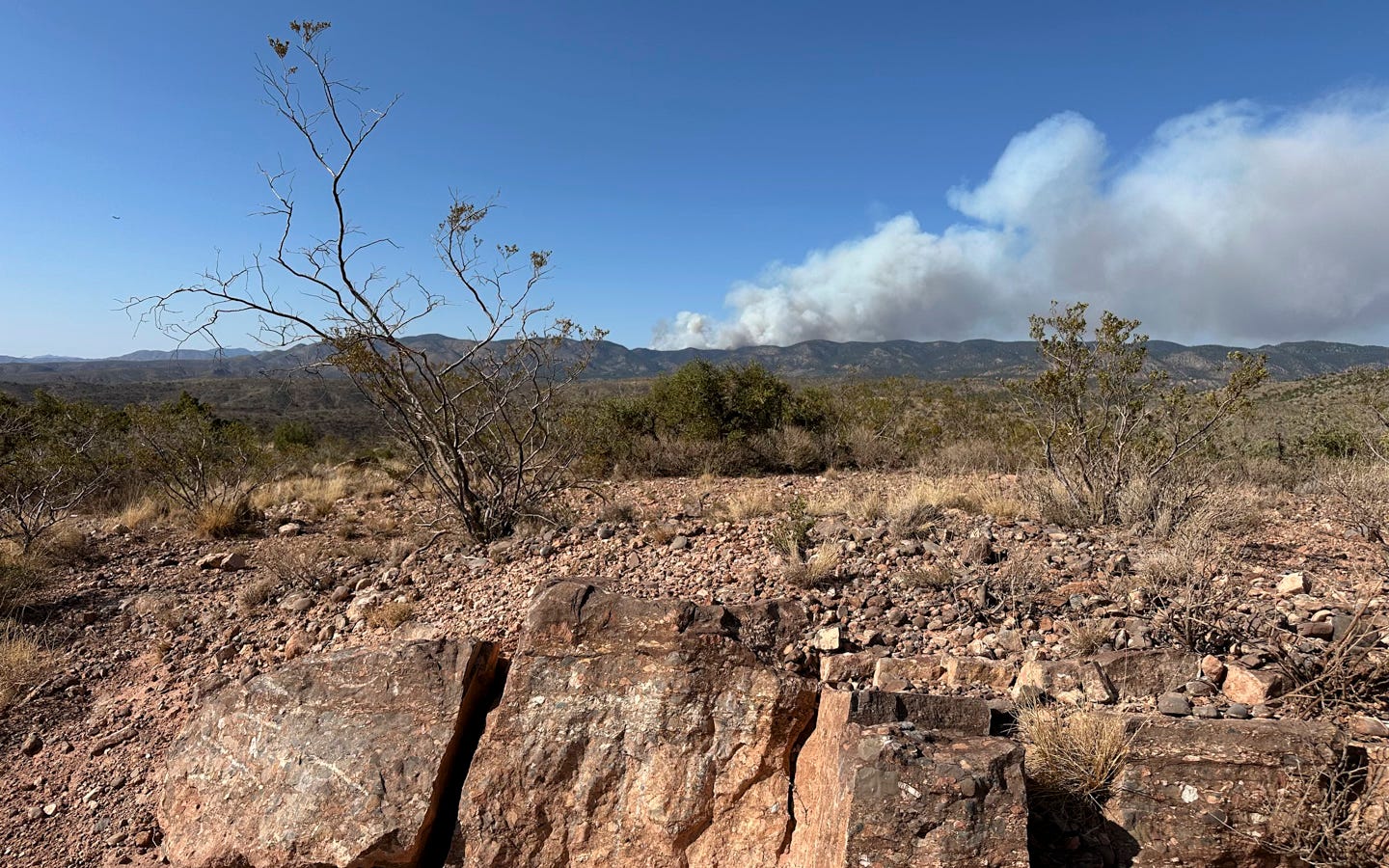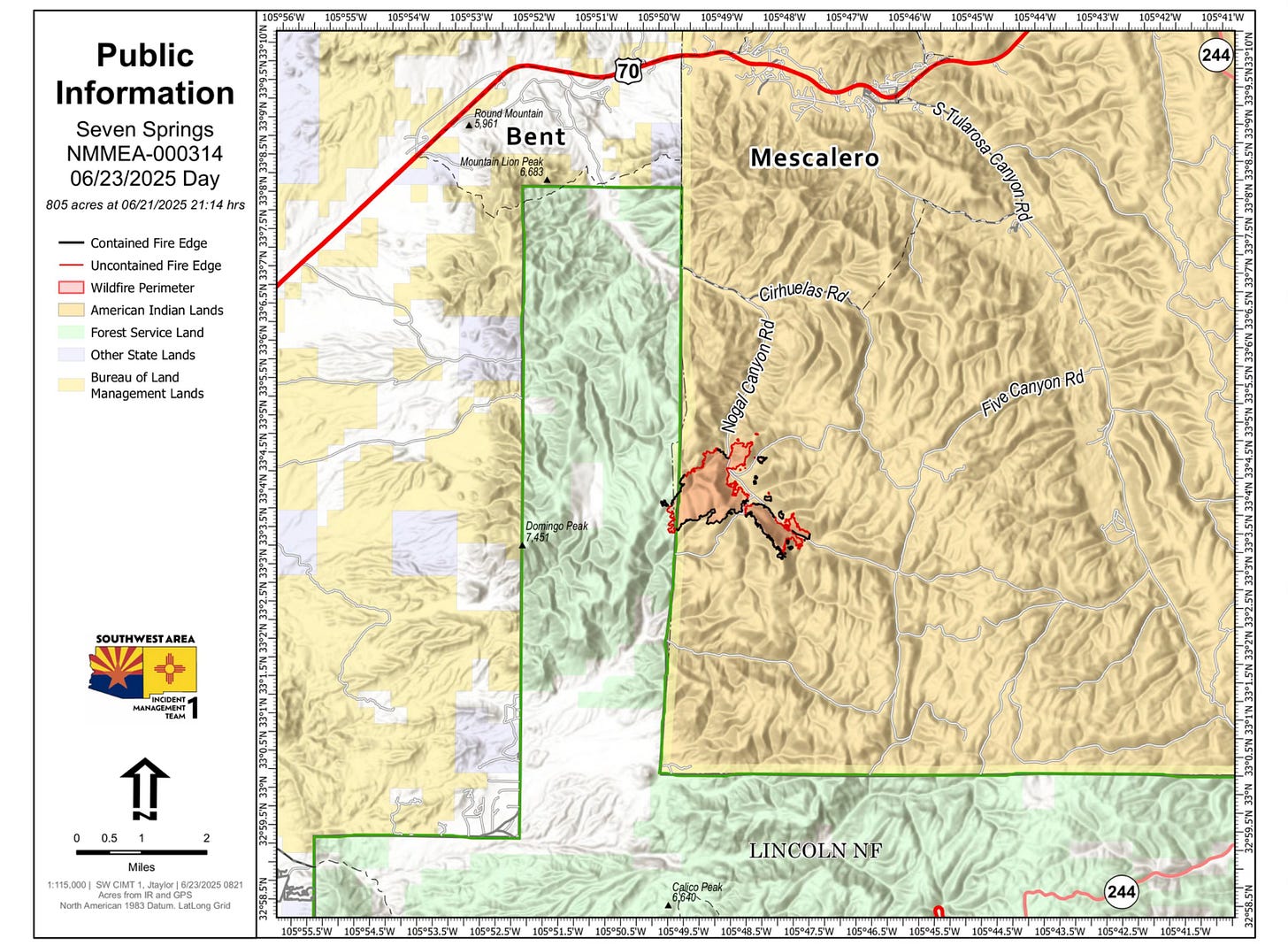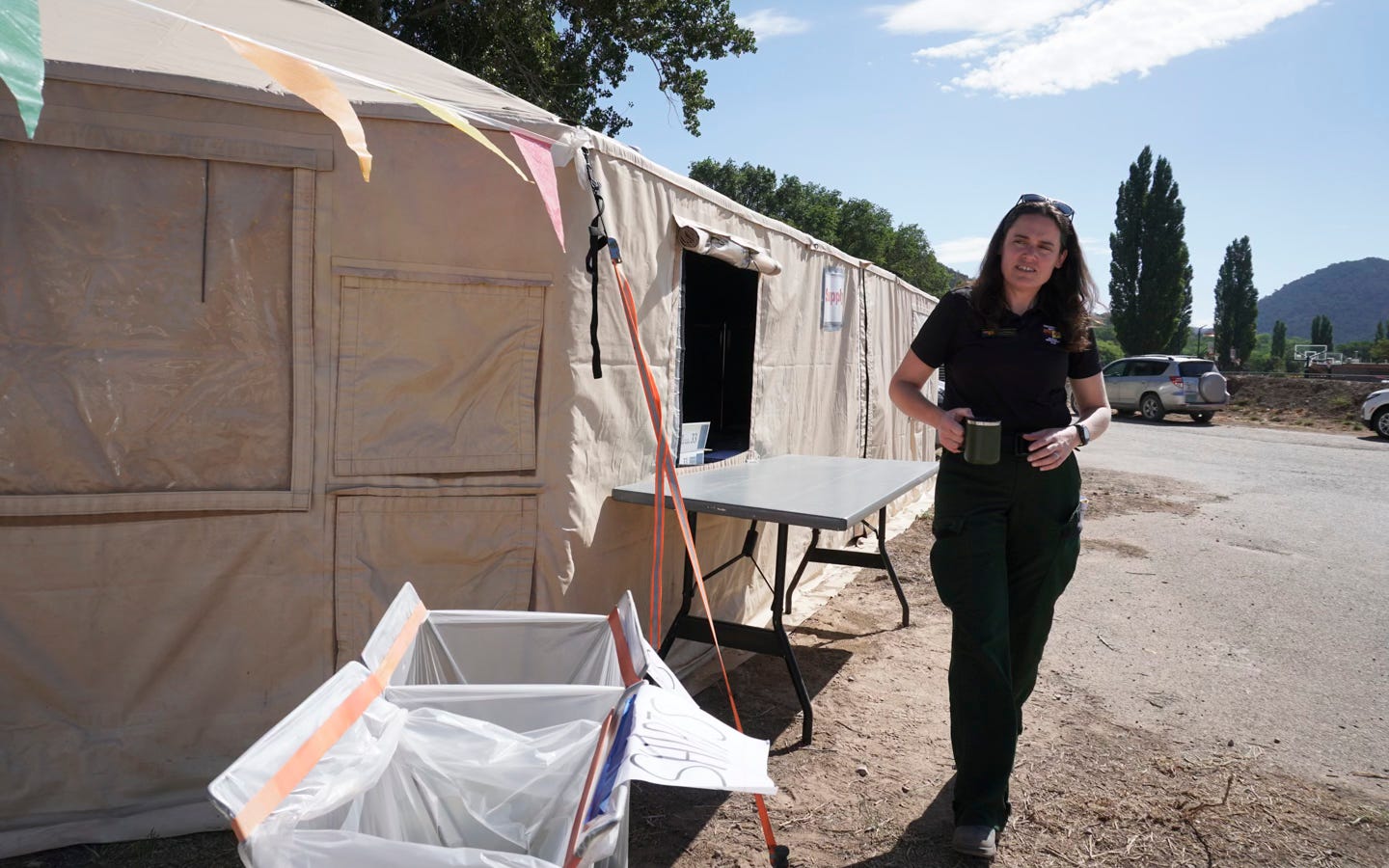Seven Springs Fire Seven Days Later
The Reader visits the Incident Command Post as crews make progress on the lightning-caused blaze

Today marks one week since the Seven Springs Fire erupted in the Sacramento Mountains.
The fire was discovered during the afternoon of June 17, 2025 exactly one year to the day of the devastating South Fork and Salt fires that burned portions of Ruidoso and surrounding communities in 2024.
Lightning is the official cause of the Seven Springs Fire according to Marya Washburn, Public Information Officer for Southwest Incident Management Team One which took over operations at the fire last week.
A statement issued by the Bureau of Indian Affairs reads, “A complete lightning report confirmed that the area of the fire experienced multiple lightning strikes on June 10, 2025, 7 days prior to the discovery of the Seven Springs Fire.”
“The fire smoldered at low intensity for several days until a combination of high temperatures, low relative humidity, lowering fuel moisture and wind caused the fire activity to increase and then smoke became visible.”
As of Tuesday morning, the fire remains at 805 acres and is 66 percent contained according to the National Interagency Fire Center. No structures have been lost or damaged.
“The crews are going to keep working for the next couple of days on increasing the containment so that this can have that perimeter around it. The fire can continue to do whatever it’s doing on the interior, but that perimeter is the goal,” says Washburn.
The fire is burning in steep, rugged and remote terrain southwest of Mescalero and northwest of Cloudcroft. Most of the burned areas lie on Mescalero Apache tribal land with a small portion on Forest Service land.
The article continues after this brief message. The Reader is proud to be supported in part by great businesses like Off the Beaten Path:
“We have over 300 people assigned to the fire as of today. You’ll start to see that number decrease as the team is getting ready to hand it back to the local agency,” says Washburn.
The Southwest Incident Management Team plans to hand the reigns to the Bureau of Indian Affairs Forestry division on Wednesday morning. In a Facebook post, the Mescalero Apache Tribe states, “The fire is expected to be fully extinguished by Thursday [June 26]…”
Light to heavy rain is forecasted for the area during the next few days which raises the possibility of flash flooding on the newly formed burn scars. A flash flood warning was issued Monday for areas within the burn scar from last year’s Salt Fire in Ruidoso. Videos on social media showed flooding on Highway 70 in the village there.
“Once the fire has reached that contained and confined status there’s going to be a burned area response team that’s going to work on how to best plan forward for rehabilitation for the burn scars and what can be done to mitigate flood risk, to help improve reforestation and growth. That team of scientists are coming in right now, and they’re working on prepping and planning,” says Washburn regarding the Seven Springs Fire.

Washburn walks past a hulking water tank where a semi-truck fills its tender. Generators buzz as she enters the mess hall; a large white festival tent where firefighters are served breakfast and dinner. Hundreds of people could fit in the make-shift dining area.
The grounds of the Mescalero Public Library have transformed into the incident command post for the fire. A small army of firefighters, management personnel and support staff move about the area.
Since the incident management team was ordered to the fire last week, yurts, command trailers, tents, kitchen supplies, refrigerator trucks, porta-potties, water tanks, firefighting clothes, and gear have all been delivered to support the cause. Washburn estimates it took 24 to 48 hours to set up the temporary post.
“A lot of folks are from Arizona, New Mexico, and then some of us are coming from slightly further afield,” says Washburn who is from Northern Colorado.
Local volunteer fire departments, tribal agencies, private contractors, inter-agency hotshot crews, and county officials have all helped to combat the Seven Springs Fire.
Washburn describes the Southwest Incident Management team as “the folks that come in and provide that middle management for the fire when the management goes beyond the capacity of the local agency, and that allows the local agency to still be able to do what they’re doing for their regular work and their jobs; and then once it comes back to a manageable level, and the fire gets contained to that level, we’re able to hand it back.”
The ride to the fire from the incident command post takes about 30 to 35 minutes and nearly an hour for some crews depending on where on the fire line they will be stationed. According to Washburn, there are four divisions of firefighters working on the blaze, each spread out at strategic locations around the burn. No smoke could be seen from the command post on Monday morning.
“Every fire is a little different; location, how hot it burned, this is much smaller than the fires you all had last year. It’s important to keep in mind that the flood risk can be occuring for a long term after the fire. The fire can be contained and can be declared out, but you might still have flood risk,” says Washburn.
She describes the morale as high amongst the firefighters. It is still early in the fire season. The smaller stature of the Seven Springs Fire and the remote nature of the burn, away from structures and people, make this a less grueling incident than others.

“When a geographic area is starting to experience multiple fires and you’re seeing multiple crews get sent out, we will look ahead and see what we need to do to preposition other crews and other management teams to be prepared if another start occurs. As a team, we saw the Trout [Fire] start, another southwest incident management team is going to that, that made us aware that we would be receiving the next fire. So there’s preparation that occurs if you’re seeing resources starting to get stretched,” says Washburn.
The National Interagency Fire Center puts the US at Preparedness Level 3 right now, on a scale from 1 to 5. In a report published today, the Center states, “as of this morning, 29 large uncontained fires are burning across the country, and an additional 32 being managed with strategies other than full suppression, mostly in Alaska. Nearly 6,000 wildland firefighters and support personnel are assigned to incidents across the United States.”
The NIFC lists 5 “large fires” currently burning in New Mexico, including the Seven Springs Fire.
“That’s one of the big roles of the incident management team is to make sure the firefighters have everything they need to do the work that they are going to do that day, and to be safe…They’re able to have the support back here while they’re out there doing the work,” says Washburn.
Washburn doesn’t anticipate more aviation resources on the fire. Slurry planes and helicopters helped combat the blaze early in its run. “We’re making progress on containment and with the weather that’s moving in, it’s difficult to have aviation in big storms, big wind events…at this point we’re moving towards aviation is probably going to go help at other fires,” says Washburn.
“Definitely be aware it’s still going on, and maintain that situational awareness for the fire but also for the potential for flash flooding,” says Washburn.
The Reader is proud to be supported in part by great companies like Instant Karma:
Promote Your Business
Learn about sponsorship opportunities for your business in support of the Reader. Contact us for more information at sponsorship-info@cloudcroftreader.com
Cloudcroft Reader is proud to be sponsored in part by great companies like:
Cloudcroft Sandwich Shop
In the heart of downtown Cloudcroft, New MexicoTularosa Communications
Internet that keeps you connected.The Stove and Spa Store
We offer a variety of services to ensure your hearth and spa dreams are met!The Lodge at Cloudcroft
Landmark Choice Among New Mexico ResortsDusty Boots Motel and Cafe
Have a beautiful, restful nightNew Mexico Rails-to-Trails Association
We Convert Abandoned Railroad Lines Into Recreational TrailsLaughing Leaf Dispensary
Discover a world of wellness at Laughing LeafInstant Karma
Adventure Within: Transformative Yoga, Ayurvedic Wisdom, Nourishing Organics, Fair Trade BoutiqueOff the Beaten Path
Eclectic gifts & original artworkFuture Real Estate
Raise your expectations.Ski Cloudcroft
Pizza and Summer Tubing start July Fourth!Cloudcroft Therapeutic Massage
Maximizing Movement, Quality of Life ImprovementHigh Altitude
Your favorite little outdoor outfitter on Burro AvenueBlushing Yucca Esthetics
Luxury facials, full body waxing, and brow servicesThe Elk Shed
Purveyors of Southwest Mountain Goods & FineryDown Under Groundwater Surveyors
We find water for youPeñasco Valley Telephone Cooperative
For all the ways you love to connect
The Cloudcroft Reader is the most widely read publication serving the greater Cloudcroft community, with 2,900+ email subscribers and 12,400+ Facebook followers. We do the reporting that no one else does.
Reach the people engaged with Cloudcroft — locals, seasonals, and visitors. Position your business just one click away.
Reader Classifieds
Where can I get connected?







A friend/former co-worker is in your neck of the woods on a prevention assignment (he's still with USFS, I left 3.5 years ago to pursue helping communities and landowners adapt to, live with, and use fire safely).
Looking at some of the gov bidding sites I see some NM areas (Santa Fe) looking for Community Wildfire Protection Plans. Folks are taking notice and on the path of taking action.
You can't prevent all wildfires, nor is that 100% ecologically desirable, but you can and should PREPARE for wildfires.
One note: your tone seems to question the finding of a lightning start. "Sleeper" fires, those that smolder unseen until rh drops and the wind picks up, are a fairly common occurrence. My first duty station on the Sequoia NF in Central California, we had "sleeper" starts that would take a day or two to pop up, but you correlate the origin with the lightning map, and usually at least with tree strikes there's scarring (or flat explosion of parts of the tree) that make the finding definitive. On the Malheur NF in Northeastern Oregon, which is dry-dry-dry forest for the most part, we had a record breaking 21-day sleeper, where it took THREE WEEKS for the fire to put up enough smoke to be seen by the fire lookout for that area.